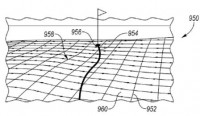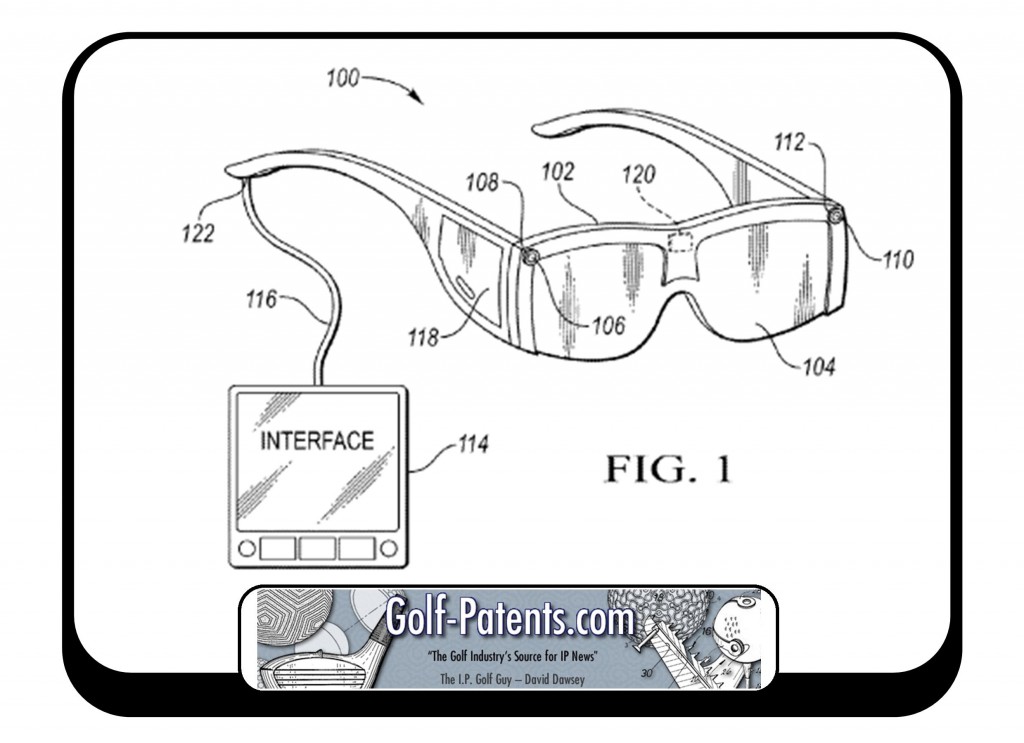No Doubt this Nike Invention Would Speed Up Play, But it Might be Considered Cheating!
It seems like Nike has their hands in everything, and heads up displays for sports is no exception. In fact, almost 2.5 years ago I covered an interesting golf related heads up display HERE. Somehow they overlooked the potential for cheating at golf via a heads up display showing you the break of a green. I kid, kind of.
Recently a patent application published that includes this, ahem, practice feature. The patent application published as US Pub. No. 20150343294 titled “golf aid including heads up display for green reading.” The application describes the invention as:
A golf aid for assisting a user in reading a green includes a user tracking system to determine the location of a user on a golf course, a heads up display, and a processor. The heads up display is configured to be worn on the user’s head, and to display an image within a field of view of the user. The processor is in communication with the user tracking system and with the heads up display, and maintains a representation of a topology for each of a plurality of golf greens, receives an indication of the location of the user from the user tracking system, identifies one of the plurality of golf greens that is the closest to the user, and displays a representation of the topology within the field of view of the user via the heads up display.
The application goes on to explain:
[0051] Referring to FIG. 10, in one configuration, the enhanced image may further include a putting aid 950 that may assist the user in reading the curvature and/or undulations of the green. Such a putting aid 950 may include a slope grid 952 and/or an ideal trajectory line 954, which, if followed, would cause the ball to roll into the cup 956. In one configuration, the slope grid 952 may include a plurality of virtual water beads 958 that may flow along the grid lines according to the absolute slope of the green 960 along the line (i.e., where a steeper gradient would result in a faster moving water bead 958 along the grid line). In another configuration, the putting aid 950 may include, for example at least one of a plurality of arrows aligned with a gradient of the green (and pointing in a down-hill direction) and an indicator, such as a ball or cursor, that translates in a direction aligned with the gradient of the green. In this manner, the golfer may easily visualize whether he/she is putting uphill or downhill, and whether the ball may break to the right or to the left. The ideal trajectory 954 may take into account the slope of the green 960, and the respective locations of the ball and cup 956.
[0052] In the enhanced image examples provided in FIGS. 9B, 9C, and 10, the ability to project an image on the ground requires an understanding of the topology of the ground relative to the eyeglasses 102. In one configuration, the topology of the golf course may be uploaded to the system 100, either prior to the start of the round, or in near-real time. The processor 202 may then pattern match the perceived topology within the more detailed, uploaded topology to align the two coordinate frames. This alignment may use GPS, visual recognition, and/or LIDAR, to identify perspective cues and/or one or more fiducials to position and orient the glasses in three dimensions within the topographical model. Using the known position and orientation of the eyeglasses 102, the processor 202 may construct a perspective view of the topology from the point of view of the user. This perspective view of the topology may then be synchronized with the field of view of the user (such as may be digitally perceived via the camera 204) and the processor 202 may display the visual overlays/enhanced imagery via the eyeglasses 102 in a manner that makes it appear to rest on the ground or objects as desired. For example, in a green reading context, the one or more putting aids 950 may be displayed such that they are coincident with the perceived portion of the green 960.
[0053] In another configuration, rather than having the topographical information uploaded from an external database, it may instead be acquired in near-real time via one or more sensors disposed on the eyeglasses 102. For example, in one embodiment, the eyeglasses 102 may include a LIDAR sensor (e.g., which may be used with the golf ball tracking system 200). The LIDAR sensor may scan the proximate terrain with a sweeping laser (i.e., ultraviolet, visable, or near-infrared) to determine the distance between the sensor and each sampled point. The processor 202 may then skin the collection of points to form a model of the perceived topology.
[0054] When used to assist the user in reading the green 960, the system 100 may dynamically adjust to display the nearest green. In one configuration, the processor 202 may, for example, continuously receive an indication of the location of the user, such as from the user tracking system 206. Using this, the processor 202 may identify one of the plurality of stored greens that is closest to the user. The processor 202 may then display a representation of the topology of the identified green 960 via the heads up display glasses, within the field of view of the user (i.e., either an overhead view or a perspective view). During a round of golf, this may allow a user to see the contours of the green as he is readying for an approach shot, as well as while putting.
Interesting, very interesting.
4 – the number of strokes I could shave off my average score if I had these glasses.
30 – the number of minutes I could shave off the average round if one of my frequent playing partners had these glasses and did not have to read a putt from every angle and then ask “is this uphill?”
Dave Dawsey – The Golf Invention Lawyer
PS – follow me on Twitter (@GolfPatents) and sign-up HERE to receive posts via email.
PPS – If you like what we are doing, please considering helping us out and make your online gear purchases through our Amazon affiliate link. Every little purchase helps us keep the site up and running! Thanks.



